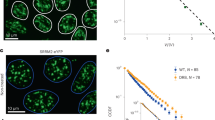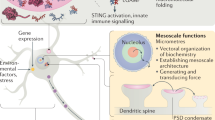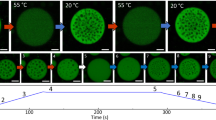Abstract
Biomolecular condensates concentrate macromolecules into discrete cellular foci without an encapsulating membrane. Condensates are often presumed to increase enzymatic reaction rates through increased concentrations of enzymes and substrates (mass action), although this idea has not been widely tested and other mechanisms of modulation are possible. Here we describe a synthetic system where the SUMOylation enzyme cascade is recruited into engineered condensates generated by liquid–liquid phase separation of multidomain scaffolding proteins. SUMOylation rates can be increased up to 36-fold in these droplets compared to the surrounding bulk, depending on substrate KM. This dependency produces substantial specificity among different substrates. Analyses of reactions above and below the phase-separation threshold lead to a quantitative model in which reactions in condensates are accelerated by mass action and changes in substrate KM, probaby due to scaffold-induced molecular organization. Thus, condensates can modulate reaction rates both by concentrating molecules and physically organizing them.

This is a preview of subscription content, access via your institution
Access options
Access Nature and 54 other Nature Portfolio journals
Get Nature+, our best-value online-access subscription
$29.99 / 30 days
cancel any time
Subscribe to this journal
Receive 12 print issues and online access
$259.00 per year
only $21.58 per issue
Buy this article
- Purchase on Springer Link
- Instant access to full article PDF
Prices may be subject to local taxes which are calculated during checkout






Similar content being viewed by others
Data availability
All raw data have been deposited in the Dryad Database: https://datadryad.org/stash/share/ZBLh5JFV-KjDQjCmqiX1qSFQbWJ3CXsd9Eu-l8rpxkM. Source data are provided with this paper. All reagents are available upon request from the authors.
Code availability
The Matlab code used to generate Extended Data Figs. 1, 2 and 3 is provided in the Supplementary Information.
References
Banani, S. F., Lee, H. O., Hyman, A. A. & Rosen, M. K. Biomolecular condensates: organizers of cellular biochemistry. Nat. Rev. Mol. Cell Biol. 18, 285–298 (2017).
Shin, Y. & Brangwynne, C. P. Liquid phase condensation in cell physiology and disease. Science 357, eaaf4382 (2017).
Sheth, U. & Parker, R. Decapping and decay of messenger RNA occur in cytoplasmic processing bodies. Science 300, 805–808 (2003).
Sheu-Gruttadauria, J. & MacRae, I. J. Phase transitions in the assembly and function of human miRISC. Cell 173, 946–957 (2018).
Su, X. et al. Phase separation of signaling molecules promotes T cell receptor signal transduction. Science 352, 595–599 (2016).
Ditlev, J. A. et al. A composition-dependent molecular clutch between T cell signaling condensates and actin. eLife https://doi.org/10.7554/eLife.42695 (2019).
Lafontaine, D. L. J., Riback, J. A., Bascetin, R. & Brangwynne, C. P. The nucleolus as a multiphase liquid condensate. Nat. Rev. Mol. Cell Biol. 22, 165–182 (2021).
Li, P. et al. Phase transitions in the assembly of multivalent signalling proteins. Nature 483, 336–340 (2012).
Xing, W., Muhlrad, D., Parker, R. & Rosen, M. K. A quantitative inventory of yeast P body proteins reveals principles of composition and specificity. eLife https://doi.org/10.7554/eLife.56525 (2020).
Guillen-Boixet, J. et al. RNA-induced conformational switching and clustering of G3BP drive stress granule assembly by condensation. Cell 181, 346–361 (2020).
Yang, P. et al. G3BP1 is a tunable switch that triggers phase separation to assemble stress granules. Cell 181, 325–345 (2020).
Sanders, D. W. et al. Competing protein-RNA interaction networks control multiphase intracellular organization. Cell 181, 306–324 (2020).
Banani, S. F. et al. Compositional control of phase-separated cellular bodies. Cell 166, 651–663 (2016).
Lyon, A. S., Peeples, W. B. & Rosen, M. K. A framework for understanding the functions of biomolecular condensates across scales. Nat. Rev. Mol. Cell Biol. 22, 215–235 (2021).
Banjade, S. & Rosen, M. K. Phase transitions of multivalent proteins can promote clustering of membrane receptors. eLife 3, e04123 (2014).
Case, L. B., Zhang, X., Ditlev, J. A. & Rosen, M. K. Stoichiometry controls activity of phase-separated clusters of actin signaling proteins. Science 363, 1093–1097 (2019).
Woodruff, J. B. et al. The centrosome is a selective condensate that nucleates microtubules by concentrating tubulin. Cell 169, 1066–1077 (2017).
King, M. R. & Petry, S. Phase separation of TPX2 enhances and spatially coordinates microtubule nucleation. Nat. Commun. 11, 270 (2020).
Dewey, D. C., Strulson, C. A., Cacace, D. N., Bevilacqua, P. C. & Keating, C. D. Bioreactor droplets from liposome-stabilized all-aqueous emulsions. Nat. Commun. 5, 4670 (2014).
Du, M. & Chen, Z. J. DNA-induced liquid phase condensation of cGAS activates innate immune signaling. Science 361, 704–709 (2018).
Freeman Rosenzweig, E. S. et al. The eukaryotic CO2-concentrating organelle is liquid-like and exhibits dynamic reorganization. Cell 171, 148–162 (2017).
Huang, W. Y. C. et al. A molecular assembly phase transition and kinetic proofreading modulate Ras activation by SOS. Science 363, 1098–1103 (2019).
Poudyal, R. R. et al. Template-directed RNA polymerization and enhanced ribozyme catalysis inside membraneless compartments formed by coacervates. Nat. Commun. 10, 490 (2019).
Love, C. et al. Reversible pH-responsive coacervate formation in lipid vesicles activates dormant enzymatic reactions. Angew. Chem. 59, 5950–5957 (2020).
Kojima, T. & Takayama, S. Membraneless compartmentalization facilitates enzymatic cascade reactions and reduces substrate inhibition. ACS Appl. Mater. Interfaces 10, 32782–32791 (2018).
Castellana, M. et al. Enzyme clustering accelerates processing of intermediates through metabolic channeling. Nat. Biotechnol. 32, 1011–1018 (2014).
Langdon, E. M. et al. mRNA structure determines specificity of a polyQ-driven phase separation. Science 360, 922–927 (2018).
Brady, J. P. et al. Structural and hydrodynamic properties of an intrinsically disordered region of a germ cell-specific protein on phase separation. Proc. Natl Acad. Sci. USA 114, E8194–E8203 (2017).
Stroberg, W. & Schnell, S. Do cellular condensates accelerate biochemical reactions? Lessons from microdroplet chemistry. Biophys. J. 115, 3–8 (2018).
Choi, J., Chen, J., Schreiber, S. L. & Clardy, J. Structure of the FKBP12-rapamycin complex interacting with the binding domain of human FRAP. Science 273, 239–242 (1996).
Schlatter, S., Senn, C. & Fussenegger, M. Modulation of translation-initiation in CHO-K1 cells by rapamycin-induced heterodimerization of engineered eIF4G fusion proteins. Biotechnol. Bioeng. 83, 210–225 (2003).
Muller, S., Hoege, C., Pyrowolakis, G. & Jentsch, S. SUMO, ubiquitin’s mysterious cousin. Nat. Rev. Mol. Cell Biol. 2, 202–210 (2001).
Varejao, N., Lascorz, J., Li, Y. & Reverter, D. Molecular mechanisms in SUMO conjugation. Biochem. Soc. Trans. 48, 123–135 (2020).
Lallemand-Breitenbach, V. & de The, H. PML nuclear bodies: from architecture to function. Curr. Opin. Cell Biol. 52, 154–161 (2018).
Melchior, F. SUMO-nonclassical ubiquitin. Annu. Rev. Cell Dev. Biol. 16, 591–626 (2000).
Bernier-Villamor, V., Sampson, D. A., Matunis, M. J. & Lima, C. D. Structural basis for E2-mediated SUMO conjugation revealed by a complex between ubiquitin-conjugating enzyme Ubc9 and RanGAP1. Cell 108, 345–356 (2002).
Coey, C. T. et al. E2-mediated small ubiquitin-like modifier (SUMO) modification of thymine DNA glycosylase is efficient but not selective for the enzyme-product complex. J. Biol. Chem. 289, 15810–15819 (2014).
Balcells, C. et al. Macromolecular crowding effect upon in vitro enzyme kinetics: mixed activation-diffusion control of the oxidation of NADH by pyruvate catalyzed by lactate dehydrogenase. J. Phys. Chem. B 118, 4062–4068 (2014).
Park, S. H., Zarrinpar, A. & Lim, W. A. Rewiring MAP kinase pathways using alternative scaffold assembly mechanisms. Science 299, 1061–1064 (2003).
Gao, Y., Roberts, C. C., Toop, A., Chang, C. E. & Wheeldon, I. Mechanisms of enhanced catalysis in enzyme-DNA nanostructures revealed through molecular simulations and experimental analysis. ChemBioChem 17, 1430–1436 (2016).
Nguyen, A. W. & Daugherty, P. S. Evolutionary optimization of fluorescent proteins for intracellular FRET. Nat. Biotechnol. 23, 355–360 (2005).
Ditlev, J. A., Case, L. B. & Rosen, M. K. Who’s in and who’s out—compositional control of biomolecular condensates. J. Mol. Biol. 430, 4666–4684 (2018).
Küffner, A. M. et al. Acceleration of an enzymatic reaction in liquid phase separated compartments based on intrinsically disordered protein domains. ChemSystemsChem https://doi.org/10.1002/syst.202000001 (2020).
Drobot, B. et al. Compartmentalised RNA catalysis in membrane-free coacervate protocells. Nat. Commun. 9, 3643 (2018).
Bouchard, J. J. et al. Cancer mutations of the tumor suppressor SPOP disrupt the formation of active, phase-separated compartments. Mol. Cell 72, 19–36 (2018).
Correll, C. C., Bartek, J. & Dundr, M. The nucleolus: a multiphase condensate balancing ribosome synthesis and translational capacity in health, aging and ribosomopathies. Cells 8, 869 (2019).
Woodruff, J. B. et al. Centrosomes. Regulated assembly of a supramolecular centrosome scaffold in vitro. Science 348, 808–812 (2015).
Yamada, K. et al. Characterization of the C-terminal diglycine motif of SUMO-1/3. Biosci. Biotechnol. Biochem. 76, 1035–1037 (2012).
Acknowledgements
We thank S. Banani and A. Rice for constructs, and all members of the Rosen Laboratory, past and present, for helpful advice and discussions. Research was supported by the Howard Hughes Medical Institute, a Paul G. Allen Frontiers Group Distinguished Investigator Award and a grant from the Welch Foundation (no. I-1544, to M.K.R.).
Author information
Authors and Affiliations
Contributions
M.K.R. and W.P. conceived the study and designed the research program. W.P. performed all experiments. M.K.R. secured funding and supervised the work. W.P. and M.K.R. wrote the manuscript.
Corresponding author
Ethics declarations
Competing interests
M.K.R. is a founder of Faze Medicines.
Additional information
Peer review information Nature Chemical Biology thanks Tanja Mittag and the other, anonymous, reviewer(s) for their contribution to the peer review of this work.
Publisher’s note Springer Nature remains neutral with regard to jurisdictional claims in published maps and institutional affiliations.
Extended data
Extended Data Fig. 1 Sensitivity of enhanced condensate activity to KM, substrate concentration, and partition coefficient.
a, Modeled ratio of total reaction rate in a phase separated solution, with and without recruitment of enzyme and substrate to the scaffold (TotalS and TotalUS, respectively, as a function of substrate concentration (plotted as [S]/KM,US) and partition coefficient (PC). Modeled for KM,US = 150 and KM,S = 50, as measured for FRB-polySH33 + polyPRM5, with identical PC values for enzyme and substrate. Modeling assumes simple, hyperbolic Michaelis-Menten kinetics (see Methods). Color scale is a relative representation of the z-axis values and goes from low (blue) to high (red). Inset is a plot of TotalS:TotalUS rate as a function of substrate concentration at a fixed partition coefficient of 50. b, Modeled ratio of TotalS to TotalUS as a function of PC and the change in KM upon recruitment of enzyme and substrate to the scaffold, KM,US/KM,S. Total substrate concentration, [S]T, set to 0.1 * KM,US. c, Same as (b), except [S]T set to 10 * KM,US.
Extended Data Fig. 2 Total scaffold rate can be less than total unscaffolded activity in certain regimes if enzyme partitioning is much less than substrate partitioning.
a-c, Modeled ratio of total reaction rate in a phase separated solution, with and without recruitment of enzyme and substrate to the scaffold as a function of substrate concentration and substrate partition coefficient (PCS). Both reactions have KM = 150. Enzyme partitioning (PCE) is 1 (a), 10 (b), and 100 (c); enzyme concentration, [E] = 0.1[S]. Model based on 0.01 droplet volume fraction.
Extended Data Fig. 3 Droplet rate increases rapidly relative to bulk as a function of partition coefficient.
a, Modeled ratio of droplet and bulk reaction rates as a function of substrate concentration and partition coefficient (PC). Both reactions are scaffolded and have KM = 50. Enzyme partitioning is identical to substrate partitioning, and [E] = 0.1[S]. b, Modeled fractional activity contributed by the droplet phase as a function of substrate concentration and partition coefficient (PC). Conditions same as in (a), with a 0.01 droplet volume fraction.
Supplementary information
Supplementary Information
Supplementary Figs. 1–8, Tables 1 and 2 and Method (modeling).
Source data
Source Data Fig. 2
Unprocessed gels for Fig. 2b,d,f.
Source Data Fig. 3
Unprocessed gels for Fig. 3a,c,
Rights and permissions
About this article
Cite this article
Peeples, W., Rosen, M.K. Mechanistic dissection of increased enzymatic rate in a phase-separated compartment. Nat Chem Biol 17, 693–702 (2021). https://doi.org/10.1038/s41589-021-00801-x
Received:
Accepted:
Published:
Issue Date:
DOI: https://doi.org/10.1038/s41589-021-00801-x
This article is cited by
-
Substrate-induced condensation activates plant TIR domain proteins
Nature (2024)
-
The molecular basis for cellular function of intrinsically disordered protein regions
Nature Reviews Molecular Cell Biology (2024)
-
Biomolecular condensates – extant relics or evolving microcompartments?
Communications Biology (2023)
-
Activation of L-lactate oxidase by the formation of enzyme assemblies through liquid–liquid phase separation
Scientific Reports (2023)
-
Biomolecular condensates in kidney physiology and disease
Nature Reviews Nephrology (2023)



